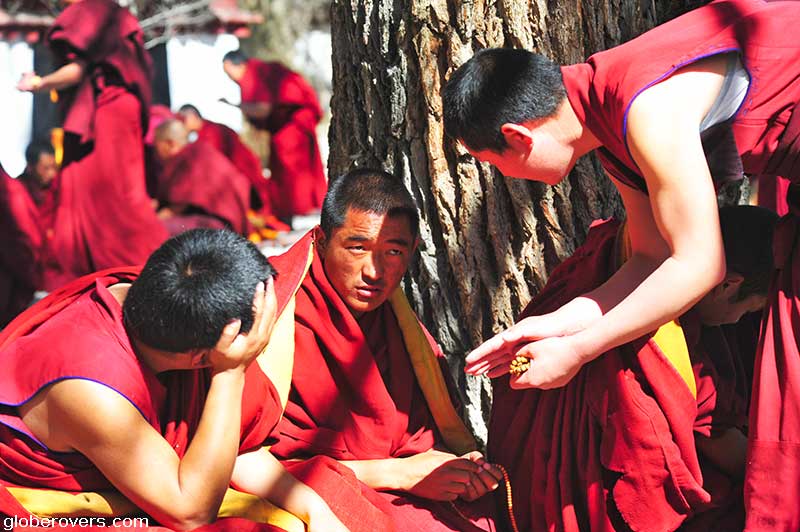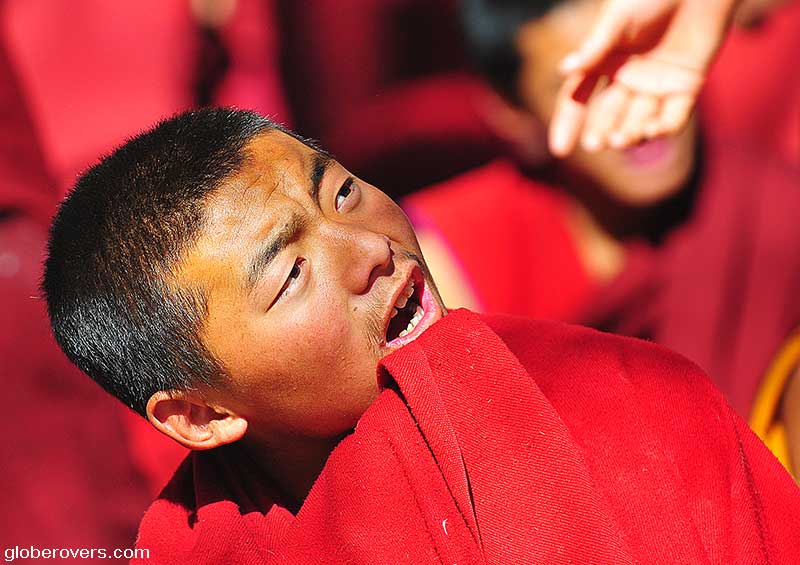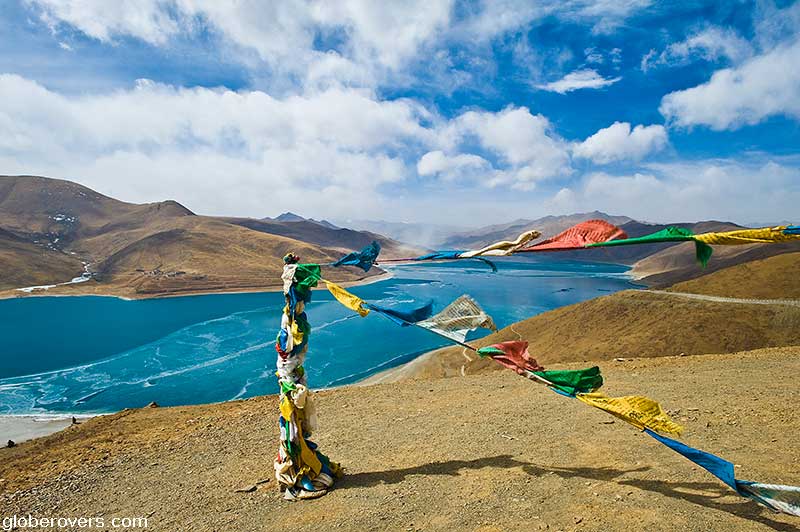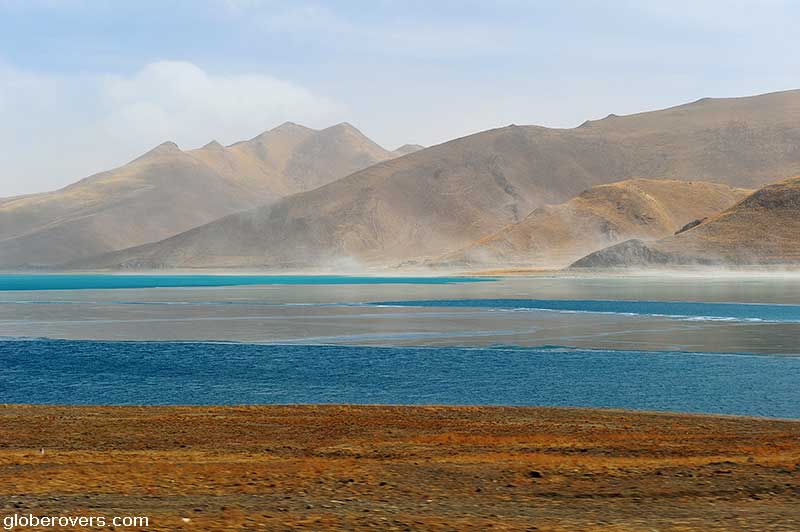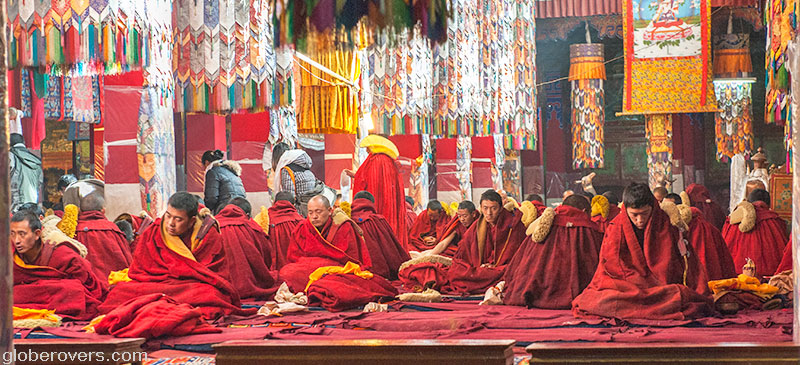
Tibet is home to numerous ancient Buddhist monasteries with a substantial number of resident monks. The so-called “Tibet Autonomous Region” (which is the area now referred to as “Tibet”), was created by China in 1950 when they invaded and annexed Tibet. The original borders of Tibet go well beyond these Chinese created borders and include large parts of adjacent Chinese provinces such as Sichuan and Yunnan. Many Tibetans (and Tibetan monasteries) are therefore located outside of the current “borders” of Tibet.
Come along as we travel through the land of the Bhikkhu and explore the ancient cities and monasteries of Tibet.
Tibet is a land of monks, in Tibetan referred to as the Bhikkhu, which is an ordained male Buddhist monastic and literally means “one who lives by alms”.
The Bhikkhu in Lhasa Monasteries
The list of monasteries inside and outside Tibet is long, and they are ranked in terms of their importance to the Tibetan Buddhist people. The Jokhang Temple and Monastery, located on Barkhor Square in Lhasa, is the most sacred temple to most Tibetan people.
The temple was founded in the 7th century and was first constructed by King Songtsän Gampo around the year 642. However, it was closed and boarded up during the reign of King Bönpo who reigned during the years of 838–841. The temple was ransacked several times by the Mongols.
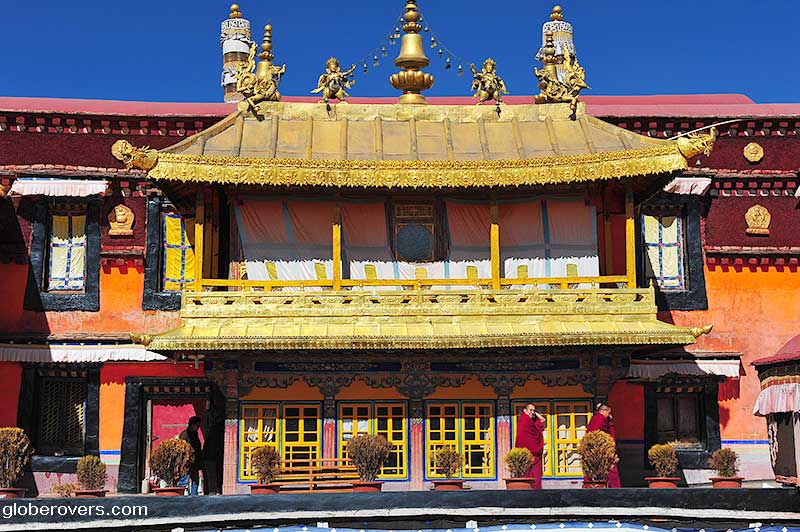
In more recent history, the Red Guards of Mao Zedong (who ruled China from 1949 until his death in 1976), ransacked and desecrated the monastery in July 1966 and thousands of Buddhist scriptures were looted and burned.
Jokhang remained one of the most important pilgrim temples throughout history. Even today a constant stream of pilgrims walk (or some crawl as they are prostrating) clockwise around the temple throughout the day and night.
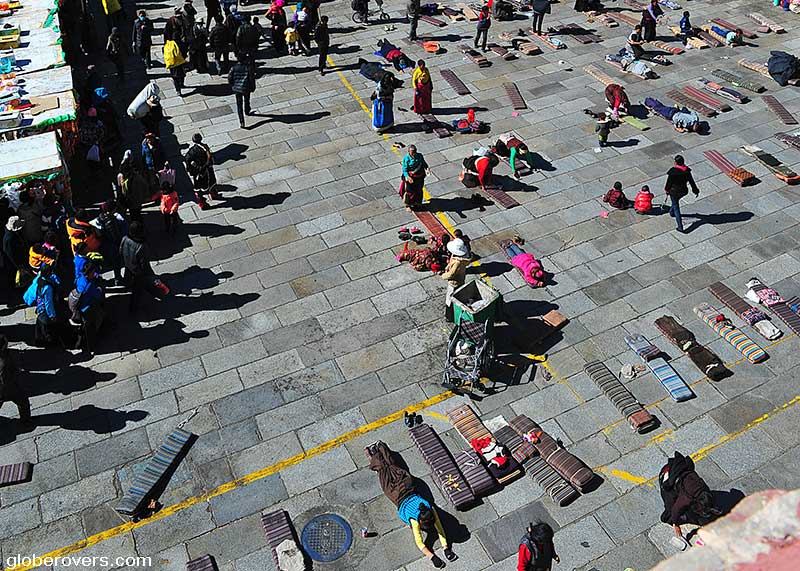
The temple is a four-story building with roofs covered with gilded bronze tiles. You can walk up with stairs to the rooftop from where you will have a great view over Barkhor Square with hundreds of pilgrims prostrating in front of the main entrance.
Feel free to bypass the long line of pilgrims into the temple as tourists are allowed to fast-track. It is a surreal experience to see the pilgrims concentrate on their prayers inside one of the oldest active religious buildings in the world.
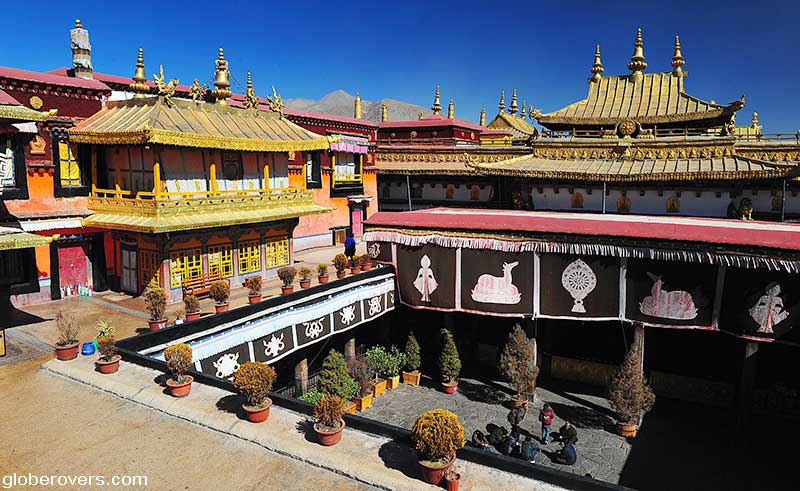
Lhasa’s Potala Palace
On a hill in Lhasa lies the world’s highest ancient palace. With its highest point reaching 3,750 metres (12,300 ft) above sea level, towering 100 metres (300 ft) above the city of Lhasa, the Potala Palace was built as the centre of the Tibetan government by the fifth Dalai Lama in 1645. The 13-stories-high palace has over 1,000 rooms and its stone walls measure three metres (10 ft) thick on average.
Potala Palace has been the main residence of the Dalai Lama until the current (14th) Dalai Lama fled to Dharamsala in India during the 1959 Tibetan Rebellion against the control of the Communist Party of China.
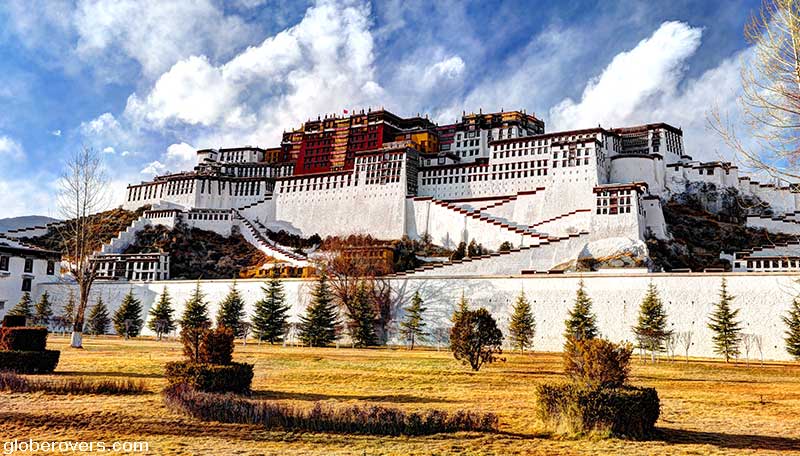
It consists of two sections: The Red Palace and the White Palace. The Red Palace is the higher of the two palaces and is made up of several chapels, including the Dalai Lama’s “house of prayer”. Here you will also find several mausoleums of previous Dalai Lamas.
The White Palace was home to ten successive Dalai Lamas and their courts, and also includes the offices of the Tibetan Government. While nearby Norbulingka is Tibet’s Summer Palace, the White Palace is known as the Winter Palace.
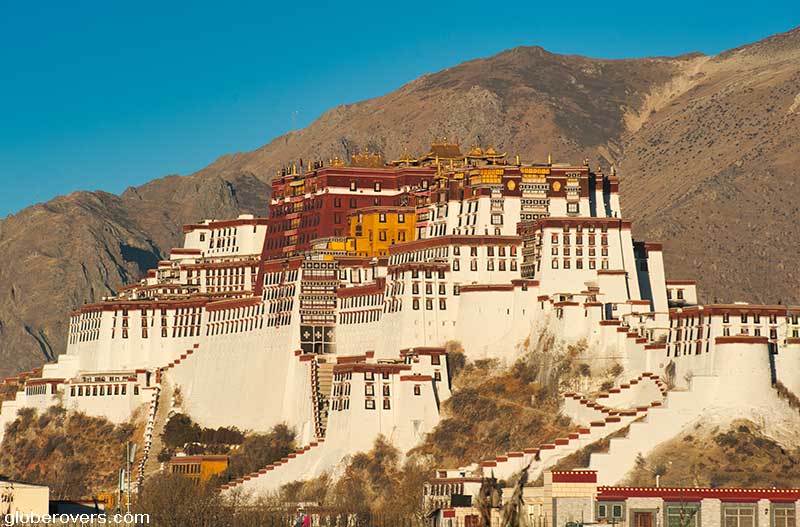
Only a small part of the palace is open for regular visitors, but more than enough to make the visit well worth.
A great place to take photos of the palace from a distance is the roof of Jokhang Temple, as well as from Chakpori Hill which lies to the southwest of the palace. Be here in the early morning to join the photographers to capture a special view of the Potala Palace irradiated by the first rays of the rising sun.

Monasteries close to Lhasa
Other highly sacred monasteries near Lhasa include the Drepung Monastery and Sera Monastery.
Located on Mount Gambo Utse (at the foot of Mount Gephel), five kilometres (3 mi) from the western suburbs of Lhasa, Drepung Monastery was built in 1416. It is the largest Tibetan monastery and one of the “Great Three Monasteries of Lhasa”, along with Sera Monastery and Ganden Monastery.
It has been reported that during the mid-1930s, the monastery could have been the biggest monastery in the world with its 7,700 monks and as many as 10,000 monks. Not surprisingly, the monastery lays claim to Tibet’s biggest kitchen which served over 10,000 monks.
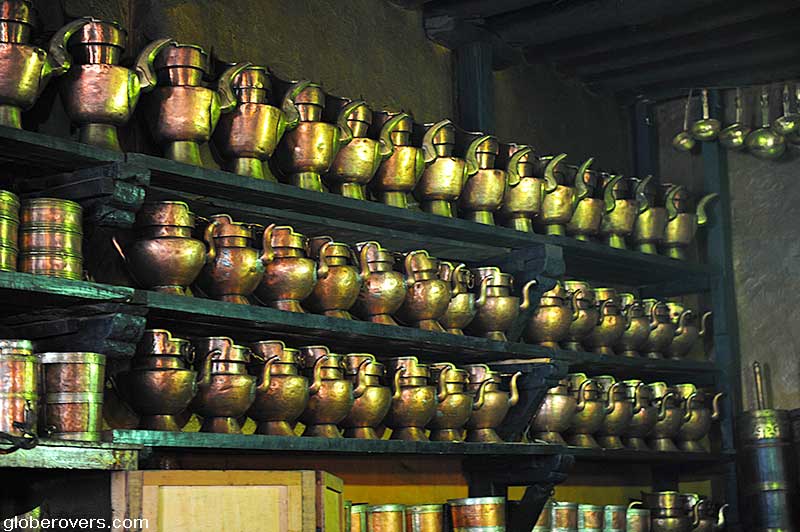
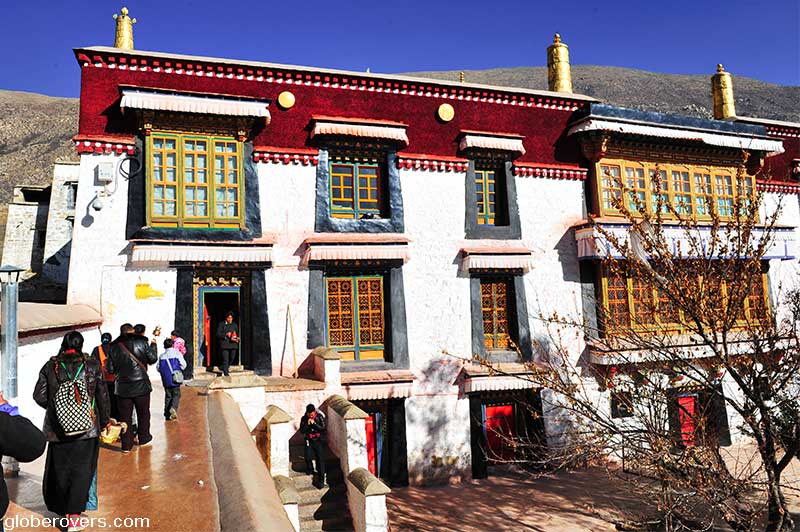

Since China’s invasion, Drepung along with several other monasteries, have lost much of their independence and spiritual credibility under the close watch of the Chinese security services. It is well known that the Chinese Communist Government has informants imbedded in the monasteries to report any sign of uprising against the China occupiers.
An interesting fact is that the “Great Three Monasteries of Lhasa”, were all reestablished in exile in the 1950s in Karnataka state in south India. Drepung and Ganden are in Mundgod and Sera is in Bylakuppe.
The monastery has some magnificent buildings with unique architecture. Among the sections not to miss are the Ganden Potrang meeting place, Coqen Hall located in the centre, the four Zhacangs “learning spaces”, a few courtyards for debating, and several statues and cultural relics.
Photos above: Monks at Drepung Monastery, Lhasa
Sera Monastery is part of the Gelgupa sect of Tibetan Buddhism and was founded in 1419. Fortunately, it managed to escape complete destruction during the Cultural Revolution. The monastery is located in a northern suburb of Lhasa at the base of Pubuchok Mountain (or Tatipu Hill) and is one of the most interesting monasteries in Tibet. Built on the gentle slope of the hill overlooking Lhasa, its white stone roads are lined with beautiful trees.
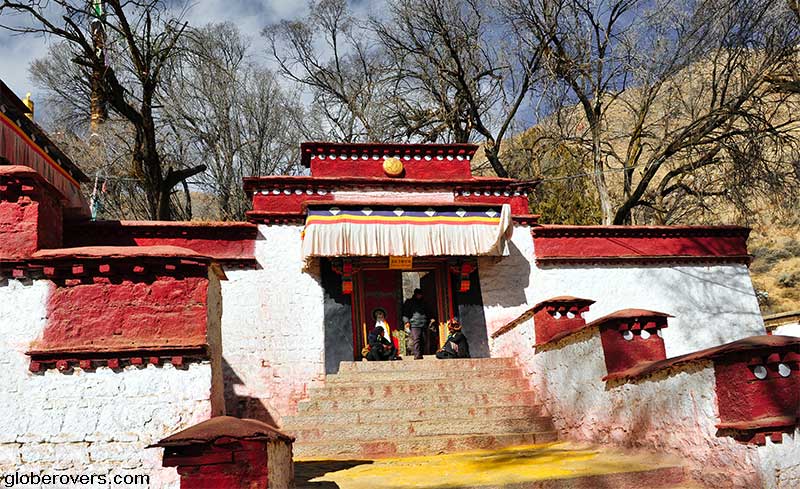
The main attraction at Sera Monastery is the activity in the debating courtyard which is reminiscent of a private garden fit for kings. Between 3 and 5 pm every weekday, young monks congregate in small groups throughout the courtyard practising their knowledge of the scriptures and Buddhist philosophy through debating one another.
It is an interesting form of debate. In each group, the speaker makes each of his points with his whole body, in particular his hands, arms, facial expressions, and tone of voice. The speaker normally stands while the “opponents” sit down. He then thrusts out his arguments climaxing with a raised voice and an enthusiastic clap of the hands toward his opponent’s face.
Each of them adds their own personal style to their gestures, which makes the debating quite entertaining for both the monks and the visitors. The atmosphere is light and visitors are welcome to take photos, though keep your distance and show respect to the “debating room”.
Photos above: Debating monks at Sera Monastery, Lhasa
Monasteries on the Tibetan Plateau
The Tibetan Plateau is rich in mystery and ancient history. The journey outside Lhasa to the towns of Shigatse, Gyantse and Lhatse pass through stunning mountain scenery with “holy lakes” decorated with prayer flags.
In Shigatse (270 km / 168 mi west of Lhasa) are the Sakya Monastery, Tashilhunpo Monastery, and the Rongbuk Monastery.
In Lhatse (156 km / 97 mi west of Shigatse) is the small Gelug monastery, and outside the town is the reconstructed Phuntsoling Monastery. North of Lhatse in the village of Lhatse Chöde is another small but significant monastery.
In Gyantse (96 km / 60 mi southwest of Shigatse) is the Pelkhor Chode Monastery.
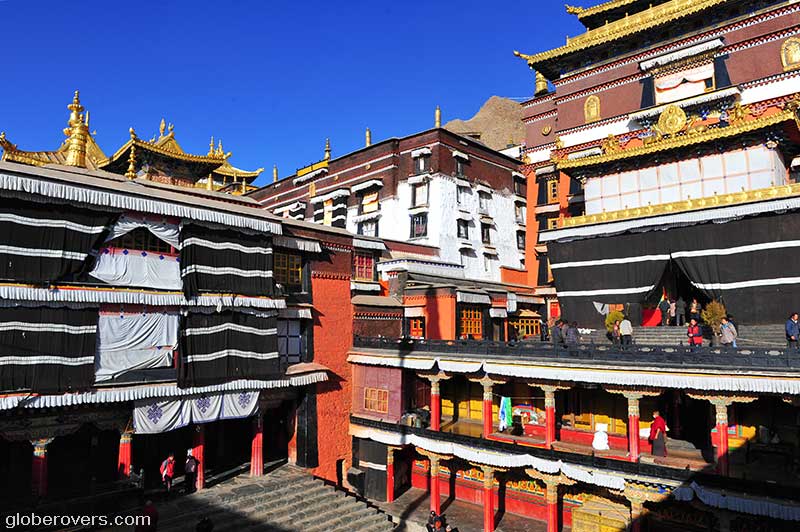

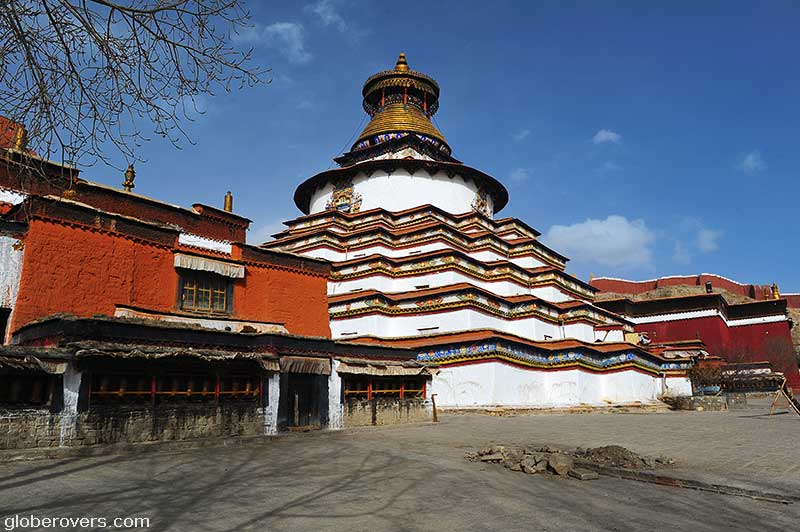
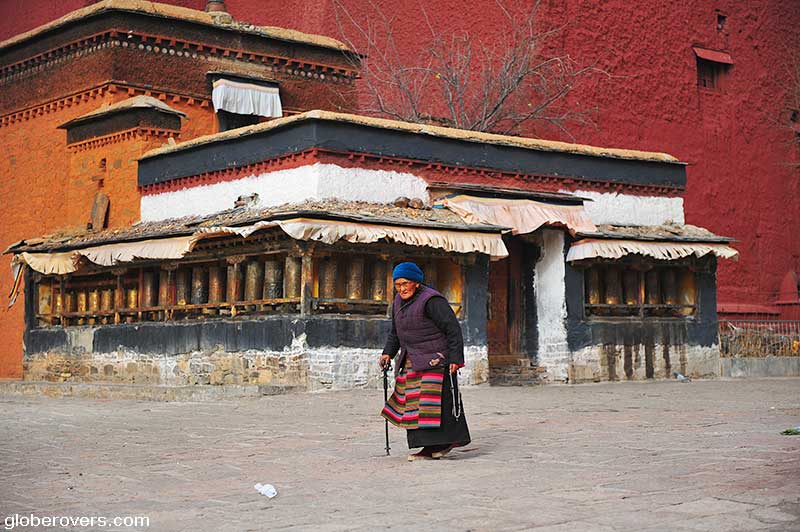
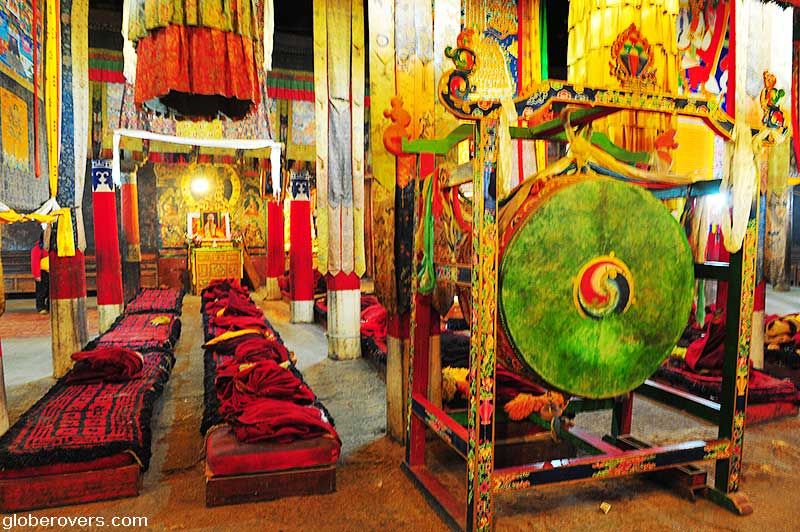
Most of the Tibetan monasteries welcome foreign tourists, as long as they pay the entrance and camera fees, which at some monasteries are quite steep. Some don’t charge any fees, though a small donation in the appropriate donation boxes is a great gesture.
Planning a trip through Tibet
Planning a trip to Tibet can be a daunting task. China has created so much red tape with rules and regulations that can change overnight making it a risky endeavour. Current regulations stipulate that all foreign visitors to Tibet must have a pre-approved Tibetan permit, and must book an accredited tour guide to “take care of them” during their entire stay in Tibet.
The guide takes responsibility for you and, in particular, outside of capital city Lhasa, should be by your side at all times. This means you need to pay for a guide every single day you spend in Tibet. Fortunately, you don’t need to be accompanied by your guide all the time in Lhasa, as long as you can reach the guide when needed. Should anything go wrong (i.e. police harassment), your tour guide will be informed and he needs to sort out “your problems”.
Foreigners are also not allowed to rent or drive a vehicle. This means you need to rent a driver and his vehicle through a travel agency. Travelling in certain rural area requires additional permits which can be arranged in Lhasa. Your friendly guide will help you, as long as you pay the permit fees.
There are many travel agencies to choose from in Lhasa or in nearby China cities such as Chengdu and Chongqing. They vary greatly in terms of fees and level of service. Make sure to check online to get recommendations.
A typical route in Tibet recommendation:
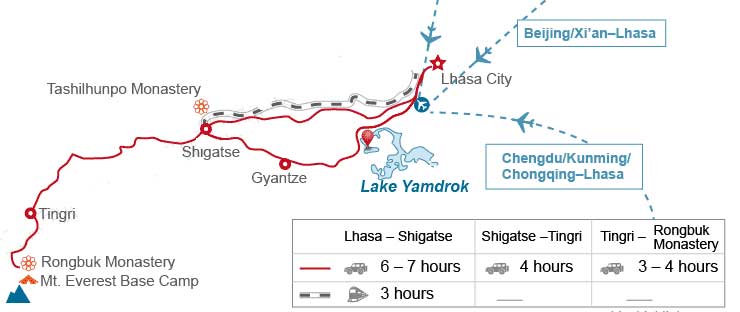
- Stay the first three nights in Lhasa to get used to the high altitude (you must spend at least two nights, but the more the better). While you are getting accustomed to the high altitude, visit the Lhasa attractions such as Potala Palace, Jokhang Temple, Barkhor Street, Drepung Monastery, Sera Monastery (watch the monks during their afternoon debates).
- On day four, get into your pre-arranged Land Rover and drive to Gyantse but sleep in the town of Shigatse. Enroute, visit the Karola Glacier, Yamtso Tso Lake, Gyatse Kumbum Stupa, and the Pelkor Chode monastery. Also, check out the Gyatse Dzong on the hill. When you arrive in Shigatse, visit the Tashi Lhunpo Monastery which is home to the biggest copper Buddha in the world.
- On day five, drive to Lhatse before crossing over the very high passes (5,200 m / 17,060 ft) to Tingri and then to Tashizong to sleep. Catch a glimpse of Mount Everest before sunset.
- On day six: Get up early to see sunrise over Mount Everest. Spend a few hours at Everest Base Camp and then take the long road back to Shigatse.
- On day seven: After a good sleep in Shigatse head back to Lhasa.
- If you go in the wintertime, be warned that some of the passes towards Everest may be closed for days. While winter is a great time to travel through much of Tibet, the high elevations may receive tons of snow and the road will then be closed for days.
☛ Read more: Land of a Million Elephants and Many Monks



Blog post and photos by Peter who has been travelling almost full-time since 2005 and has been to over 122 countries. He visited several countries, such as Japan, more than 20 times. Peter is Editor-in-Chief and Publisher of GlobeRovers Magazine, an independent travel magazine focused on intrepid destinations.




